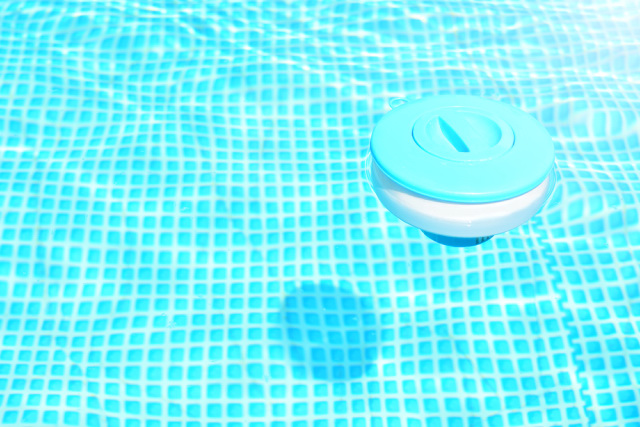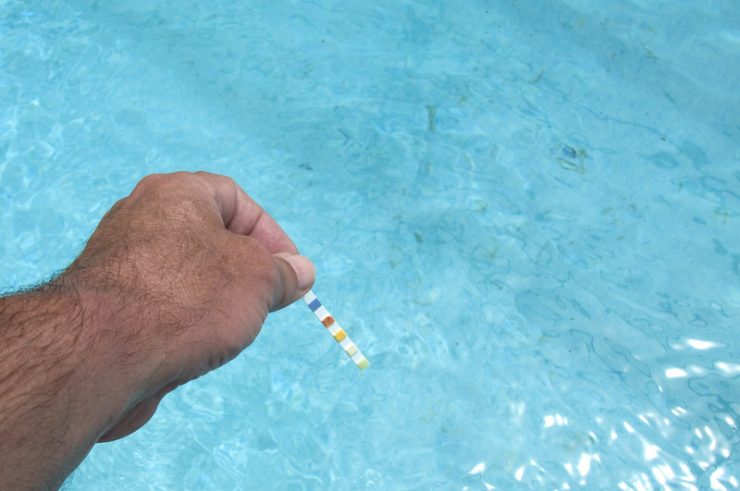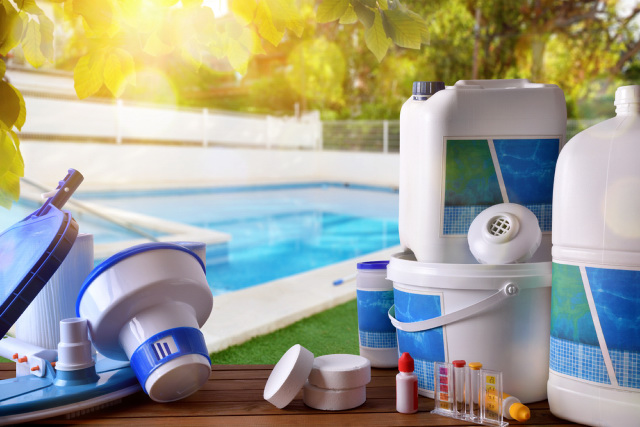Have you tested your pool’s chlorine levels and discovered that there are different types of chlorine? Free chlorine vs total chlorine…wondering what’s the difference? In this article, you will learn what they are, how they differ, and what the ideal levels should be.

When you add chlorine to your pool, free chlorine is created, which sanitizes the pool water. Total chlorine is the amount of free chlorine and combined chlorine, but the level of total chlorine does not reflect how healthy the water is unless you know how much free chlorine and combined chlorine are present.
Article Contents
Free Chlorine vs Total Chlorine vs Combined Chlorine – What’s the Difference?
Many people know chlorine as a chemical that can kill bacteria and microorganisms. To maintain pool water quality, every pool owner will be checking chlorine levels on a regular basis.
Hearing all the different terms, such as free chlorine, total chlorine, and combined chlorine, can be very confusing and overwhelming, especially for a new pool owner. Trust me, you are not alone, so let’s clear this up.
What is Free Chlorine?
When you add chlorine to your pool water, it first breaks down into hypochlorous acid (HOCI). As it dissolves further and combines with oxygen, hypochlorite (CIO) ions are created. Simply put, these chemicals are epic bacteria killers and are FREE to clean the pool water in this state. This is why we call it “free chlorine.”
Free Chlorine is available and free to kill bacteria
As you add more chlorine to your pool to sanitize it, you’re increasing the amount of free chlorine in the water, the levels should be around 3 ppm (parts per million).
What is Combined Chlorine?
Combined chlorine is formed when the free chlorine is doing its job of sanitizing the pool, and the free chlorine is combined with contaminants. This process then decreases the amount of free chlorine as it transforms into “combined chlorine”.
Combined Chlorine is used up chlorine. It’s free chlorine combined with contaminants
The chlorine is doing its job of sanitizing the pool water, but you still want to ensure that the free chlorine levels are higher than the combined chlorine levels so you can maintain an ideal chemical balance.
Combined chlorine levels should never exceed 0.5 ppm as this can harm your health. You may notice a strong chlorine smell or have itchy skin if it’s too high, and you will need to shock the pool to sort this out. Ultimately, you want the combined chlorine levels to be at 0, as this will tell you that your pool water is clean and healthy.
What is Total Chlorine?
If you add the amount of free chlorine and combined chlorine, that gives you the total chlorine in your pool. This can be interesting, but it’s more important to be aware of the other two types of chlorine levels.
Total Chlorine = Free Chlorine + Combined Chlorine
You want to ensure that the amount of free chlorine in your pool is higher than the combined chlorine, so making sure you have those results are key to maintaining the pool water quality overall.
From this, we could say that if you tested the total chlorine level to be 2.8 ppm, with the free chlorine levels being 2.7 ppm and the combined chlorine level being 0.1 ppm, you have a healthy swimming pool to enjoy!
How to Test Total and Free Chlorine Levels In Your Pool

To test the levels of total and free chlorine levels in your pool, the two most popular methods are using a chlorine test strip or chlorine test kit.
Testing Free & Total Chlorine – Test Strips
When you hold a test strip in your pool water, the chemical pad on the end of the stick reacts with the water. It will give you an estimate of how much free chlorine, combined chlorine, and total chlorine there is as the chemical pad changes color.
Testing Free & Total Chlorine – Liquid or Drop Test Kit
Alternatively, with a chlorine liquid or drop test kit, you will take a water sample from the pool and add some drops of reagent.
The water will change color, and you can match it to the color panel provided to determine the results. There are a variety of test kits out there, but essentially all work using a titration method.
After you test your pool’s free chlorine vs total chlorine level, you can adjust the levels accordingly to bring the pool back into balance.
How to Fix Your Pool’s Chlorine Levels
So, you’ve tested your pool’s different chlorine levels and discovered that they are out of balance. Now what? Check out the table below to find a solution to the issue.
How to Fix the Chlorine Levels in Your Pool
| Problem | Solution |
| Free chlorine level is too high and total chlorine level is too low | Use a chlorine neutralizer or wait for chlorine to naturally lower |
| Both free chlorine and total chlorine levels are too high | Use a chlorine neutralizer or wait for chlorine to naturally lower |
| Free chlorine level is too low and total chlorine is too high | Shock the pool by adding a large amount of chlorine |
| Free chlorine and total chlorine levels are too low | Add more chlorine |
As you can see from the table above, the amount of free chlorine and total chlorine levels in your pool can be easily fixed by either adding more chlorine to the water or by using a chlorine neutralizer to bring the levels back down.
There are other methods to decrease the chlorine levels in your pool. These are not quick fixes but are better than using neutralizers:
- Diluting the water by removing some of the chlorinated water and adding in fresh water
- Waiting and allowing the sunlight to burn it off – can take 1 – 4 days depending on how much chlorine is in the water
If you find that the chlorine levels still remain low after shocking the pool or the chlorine is not as effective, there may be a high chlorine demand problem due to all the contaminants in the water.
This will most likely only occur if you have left the pool and not maintained it for some time if it’s getting a lot of use, or if you have algae. If that’s the case:
- Shock it again using calcium hypochlorite & keep repeating until the pool maintains the normal chlorine levels. It may take several days.
- Check your cyanuric acid levels and ensure it’s between 30 – 50 ppm.
- Check your pH level is 7.4 – 7.6
When adjusting chlorine levels, always be mindful of the other chemical levels in your pool as that can determine how effective the chlorine is.
Are Total, Combined and Free Chlorine Levels the Same in Salt Pools and Chlorine Pools?

Yes, don’t think that salt pools are chlorine-free or need less sanitation than chlorine pools! Both salt and chlorine pools require the same levels of chlorine and have the same types of chlorine (free, combined, total).
However, salt pools are generally better at keeping the free and combined chlorine levels more stable due to the salt chlorine generators aka chlorinators that they use.
Costing around $800 USD – $1500 USD for a chlorinator (SWG – saltwater chlorine generator) and around $300 USD – $400 USD per year for chemicals including chlorine, they can be well worth it if you know you aren’t the best with pool maintenance.
That means that chlorine pools require a bit more maintenance when it comes to testing the chlorine levels more regularly and physically adding chlorine into the pool via a tablet, powder, or liquid to maintain balance. This costs around $500 USD – $800 USD in chemicals per year.
Overall, keep both your salt pool and chlorine pool’s free chlorine levels around 3 ppm, and the total chlorine level should be around the same (with the combined chlorine level around 0).

